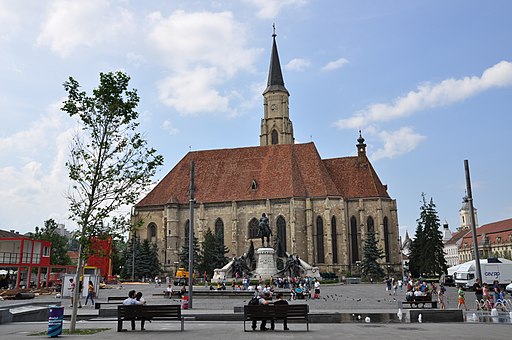St. Michael Roman Catholic Church

History
Its 76-metre tower (80 metres including the cross) is the tallest church tower in Transylvania. Its nave is 50 m long and 24 m wide; the sanctuary is 20 m long and 10 m wide.
A church dedicated to Saint Michael also stood on the site in the 13th century. By a charter of 19 August 1316, King Charles I of Hungary confirmed the privileges granted to the town by King Stephen V of Hungary, including its right to elect its parish priests and judges freely. Within a few years, construction of a new, spacious church was begun to accommodate the town's increased population. It took more than a hundred years to build, with funds provided partly by the donating citizenry and partly by those seeking indulgence. The earliest surviving document dates from 1349, when the Archbishop of Avignon and fifteen bishops granted indulgence for those who donated to the lighting and furnishing of the church of St Michael and the chapel of St James.
At the end of the 14th century, the church and the cemetery were surrounded by a defensive wall due to the growing Turkish threat.
The construction was completed during the reign of King Sigismund of Hungary, between 1419 and 1437, as indicated by the royal coat of arms of the Hungarian king, German emperor and Czech king above the main western gate.
In 1437, as a punishment for opening the gates to the peasant uprising, the privileges of the town were abolished and only restored on St Michael's Day in 1444. The statue of St Michael above the coat of arms is a reference to this. Completion of the facade and construction of the tower continued into the 1450s.
The church was damaged by fire in 1489 and restored with the help of King Matthias of Hungary. The vault of the sanctuary was rebuilt in 1498. The tower was built between 1511 and 1545, and of the two planned towers, only the northern one was built. The tower was destroyed by fire in 1697 and was rebuilt in Baroque style only between 1742 and 1744. This tower was damaged by lightning and an earthquake in 1763 and had to be demolished. The foundation stone of the neo-Gothic tower, which can still be seen today, was laid in 1837 and completed in 1859. Originally there was a passageway under the tower, which was removed at the beginning of the 20th century.
After the great plague epidemic of 1738-1744, a votive gate was erected in front of the main entrance. The three-entrance gate, decorated with statues of the Archangel Michael and the saints who defended against the plague (St John the Baptist, St John the Evangelist, St Sebastian, St Roch, St John of Nepomuk and St Charles of Borromeo), was moved to the front of the church of St Peter during the 1899 renovation.
The organ was built in 1763 by Johannes Hahn, a master craftsman from Nagyszeben, but it has been rebuilt several times.
The church was used by the Protestants from 1545, and by the Unitarians from 1566 to 1716, with an interruption of two years. At that time the original furnishings were destroyed and the walls were whitewashed. In 1604-1605, the imperial commander Giorgio Basta gave the church to the Jesuits in place of the destroyed church in Farkas Street. On 30 March 1716, on the orders of the imperial commander-in-chief Stephan von Steinville, the church was taken by military force from the Unitarians and reverted to the Catholic Church. Under the Protestants the liturgical equipment was destroyed and replaced in the 18th century. The Baroque altar was erected in 1725.
By 1898 a paved walkway was built around the church, and the church garden was surrounded by a cast iron fence designed by Pákey Lajos. In 2009, a statue of Bishop Márton Áron, sculpted by Bocskay Vince, was erected in the church garden.
Throughout its history, St Michael's Church has been the scene of many notable historical events. Most of the time it has been the venue of the nearly fifty or so Transylvanian country assemblies convened in Kolozsvár. Among the Transylvanian princes, Báthory Zsigmond was inaugurated here for the third time (27 March 1601) and Rákóczi Zsigmond (12 February 1607), Báthory Gábor (7 March 1608) and Bethlen Gábor (13 October 1613) were elected princes in the church.
